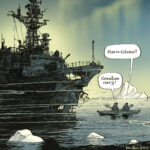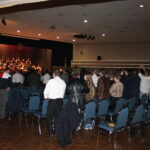Kateryna Bandura for New Pathway – Ukrainian News.
The curated exhibit “Power of Six” has brought together six Ukrainian artists from Toronto, who share in their love for art and want to share their life vision with the community. Two dozen people visited the opening on July 5 at The Helson Gallery of the Halton Hills Cultural Centre in Georgetown, ON. The attendees also had a chance to meet five artists: Maria Antoniv, Alexander Gutyrya, Oleh Nedoshytko, Ihor Polishchuk and Roman Zuzuk. Natalia Laluq, the sixth artist, could not attend the opening.
The two floors of the Centre were taken up by 26 pieces, totaling in $53,650 worth of art.
The Helson Gallery curator Judy Daley applauded the exhibit’s effort to reach a broad audience while infusing the local arts community with new creative energy and ideas.
“Seen as a whole, the cultural background that has brought these six artists together is transcended and the viewer is able to find multiple readings in their diverse approaches,” Daley said in the curator’s statement.
The six artists come from different educational backgrounds, and use different painting styles to convey their view of the world.
“Maria’s abstracted florals are a fresh take on the still life genre,” Daley’s statement read.
Maria Antoniv has been recognized for her unique vision and sensitive eye to the world of flora. Her works have appeared in numerous solo and group exhibitions in Europe, Canada, the U.S., and Ukraine. Three of her pieces in the “Power of Six” are done in acrylic, two – in oil. All are infused with colour and energy, and the paint that’s been thrown on top creates eager vibes.
Denyse Churchill, the assistant curator for the exhibit, said that Antoniv has participated in an open plein air – a competition of outdoor painting hosted by The Helson Gallery. It took place in Acton, ON, during the weekend before the opening. Antoniv’s piece was very expressive and soothing, and was awarded second prize, she said.
“We had a choice to paint by the pond nearby or go inside,” Antoniv told NP-UN, “and I saw the water lilies and, of course, I choose lilies as my painting subject.”
The richly layered textures of Alexander Gutyrya’s two- and three-dimensional works are pleasantly vibrant. Gutyrya is a painter and a sculptor, born in Bakhmut, Ukraine, who now owns a studio in Toronto. Previously, his works have been exhibited in Ukraine, France, Hungary, Germany, Italy and Finland. His “Power of Six” pieces include one oil and three acrylic paintings, and one wooden statue. The statue, titled “Motion”, was first carved out of wood and then painted with oil paints. Gutyrya said that he believes that the statue is feminine because it looks full of passion.

Alexander Gutyrya’s sculpture “Motion”, with his artwork in the background
To Denyse Churchill, a curator’s assistant, the statue carries a lot of energy, especially because of its vibrant colors. Muted colours on the sides create a shadow, and the eye is tricked into thinking there’s depth to it. The circle, she believes, could represent looking through into another world. She also said that the size is complimenting the statue’s design.
The third “Power of Six” artist, Oleh Nedoshytko, offers abstract pieces. The Odesa-born artist has exhibited world-wide, including shows in Canada, the U.S., Poland, Austria and Germany. His “Power of Six” artwork include four acrylic paintings. Churchill commented on the texture of the paintings, saying that his use of a palate knife gives the artwork “a lot of depth” and “a lot of texture”.
Judy Daley, in her curator statement, said that “the abstractions of Oleh Nedoshytko and the plein air and interior scenes of Natalia Laluq radiate both artists’ confident painterly technique”.
Natalia Laluq is a visual and ceramic artist, who’s paintings in the “Power of Six” portray plein air and interior scenes. One of those is painted on fabric instead of canvas; this adds texture to the artwork.
“After the paint was on, she etched into it with the back of her brush,” Churchill said. This technique leaves deep trenches on the painting, but it adds dimension and depth.
The fifth artist is Lviv-born Ihor Polishchuk, who takes inspiration from literary and surrealistic realms. His works have been exhibited in solo and group shows in Europe, Canada and the U.S., and are on permanent display at the Kontakt TV Station in Toronto. He also owns Excalibur Art Restoration Inc. The “Power of Six” exhibit displays two of his acrylic paintings.
Polishchuk’s work is very detailed; Churchill said she imagines that there is a lot of hidden meanings and symbolism in his art.
“I love abstract type of artwork, and I love his attention to detail,” Churchill said.
The last of the six artists, Roman Zuzuk, creates encaustic art; this involves layering coloured bees wax onto hard surfaces, typically cardboard. For “Power of Six”, Zuzuk painted one of his three encaustic paintings on paper. The other two paintings were oil works.
Encaustic artists might start with a sketch, which is what Churchill said she imagined Zuzuk did, based on the pencil marks underneath the wax.
“A lot of people who work with encaustic also put other things into it,” Churchill said. “They’ll put papers and torn up bits of fabrics, colour paper and feathers, and all kinds of little objects. They’ll burry those within the layers of wax. It’s really beautiful. You can see sort of a layer to it, and sort of a chocolate-y feel.”
Zuzuk’s painting “Couple” is an example of encaustic art. The woman has an illustrated forest above her head and the man has a city above his. Zuzuk interpreted his painting as a “simplified perception of the world”, but Churchill called it “whimsical” and “wholesome”.
Putting an art gallery together is a lot of work, Churchill said. It’s almost like a puzzle: the size, the theme and the colour pallet determine the place of each piece. Even the colour of the walls plays a role. But it all adds to the overall experience. Churchill said that people don’t always need to know what the artist’s intentions were, only that they enjoy it for their own personal response.
“We’re all different people,” she said. “So, when we look at something, something very pleasant, soothing for me may not be for another. And that’s a really good thing – not to know too much, sometimes.”
The “Power of Six” exhibit is open at the Halton Hills Cultural Centre until September 22, 2019.
Share on Social Media




































